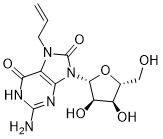| Cas No.: | 121288-39-9 |
| Chemical Name: | Loxoribine |
| Synonyms: | Guanosine,7,8-dihydro-8-oxo-7-(2-propen-1-yl)-;7-Allyl-7 8-Dihydro-8-Oxoguanosine 95;7-ALLYL-7,8-DIHYDRO-8-OXOGUANOSINE;7-Allyl-7,8-dihydro-8-oxoguanosine (Loxoribine);7-Allyl-7,8-dihydro-8-oxoguanosine (Loxoribine);7-allyl-8-oxoguanosine;RWJ 21757;7-allyl-8-oxo-G;Loxoribine;7,8-Dihydro-8-oxo-7-allyl-guanosine;7,8-Dihydro-8-oxo-7-(2-propenyl)guanosine;Guanosine, 7,8-dihydro-8-oxo-7-(2-propenyl)-;7-Allyl-2-amino-9-(3,4-dihydroxy-5-hydroxymethyl-tetrahydro-furan-2-yl)-7,9-dihydro-1H-purine-6,8-dione;7-Allyl-7,8-dihydro-8-oxoguanosine 95%;7-ALLYL-7 8-DIHYDRO-8-OXOGUANOSINE 95;7-Allyl-8-oxoguanosine |
| SMILES: | C=CCN1C2=C(N(C1=O)[C@H]3[C@H](O)[C@H](O)[C@H](O3)CO)NC(NC2=O)=N |
| Formula: | C13H17N5O6 |
| M.Wt: | 339.30398 |
| Purity: | >98% |
| Sotrage: | 2 years -20°C Powder, 2 weeks 4°C in DMSO, 6 months -80°C in DMSO |
| Description: | Loxoribine (7-Allyl-8-oxoguanosine) is a guanosine analog with anti-viral and anti-tumor activities. Loxoribine is an orally bioavailable and selective Toll-like receptor (TLR) 7 agonist[1][2][3]. |
| Target: | TLR7[1] |
| In Vivo: | Loxoribine (2 mg; s.c.or i.v.) activates murine natural killer (NK) cells in vivo[3]. Animal Model: 8-12 weeks male CBA/J mice[3] Dosage: 2 mg Administration: Subcutaneous or intravenous injection Result: activates murine natural killer (NK) cells in vivo. |
| In Vitro: | Loxoribine induces maturation of human monocyte-derived dendritic cells DCs and stimulates their Th-1- and Th-17-polarizing capability[2]. Loxoribine (250 μM; 48 hours) stimulates maturation of MoDCs as shown by up-regulation of CD80, CD83, CD40, CD54 and CCR7[2]. loxoribine activates cells of the innate immune system selectively via the Toll-like receptor (TLR) 7/MyD88-dependent signaling pathway[1]. |
| References: | [1]. Heil F, et al. The Toll-like receptor 7 (TLR7)-specific stimulus loxoribine uncovers a strong relationship within the TLR7, 8 and 9 subfamily. Eur J Immunol. 2003 Nov;33(11):2987-97. [2]. Dzopalic T, et al. Loxoribine, a selective Toll-like receptor 7 agonist, induces maturation of human monocyte-derived dendritic cells and stimulates their Th-1- and Th-17-polarizing capability. Int Immunopharmacol. 2010 Nov;10(11):1428-33. [3]. Pope BL, et al. In vivo enhancement of murine natural killer cell activity by 7-allyl-8-oxoguanosine (loxoribine). Int J Immunopharmacol. 1992 Nov;14(8):1375-82. |

 DC Chemicals' products qualify for U.S. tariff exemptions. We guarantee no price increases due to customs duties and maintain stable supply, continuing to deliver reliable research solutions to our American clients.
DC Chemicals' products qualify for U.S. tariff exemptions. We guarantee no price increases due to customs duties and maintain stable supply, continuing to deliver reliable research solutions to our American clients.





















